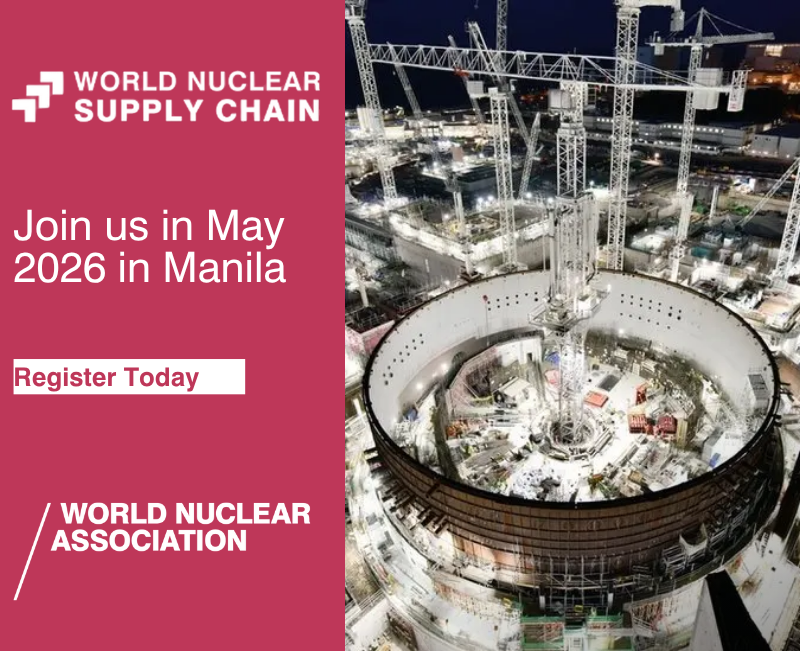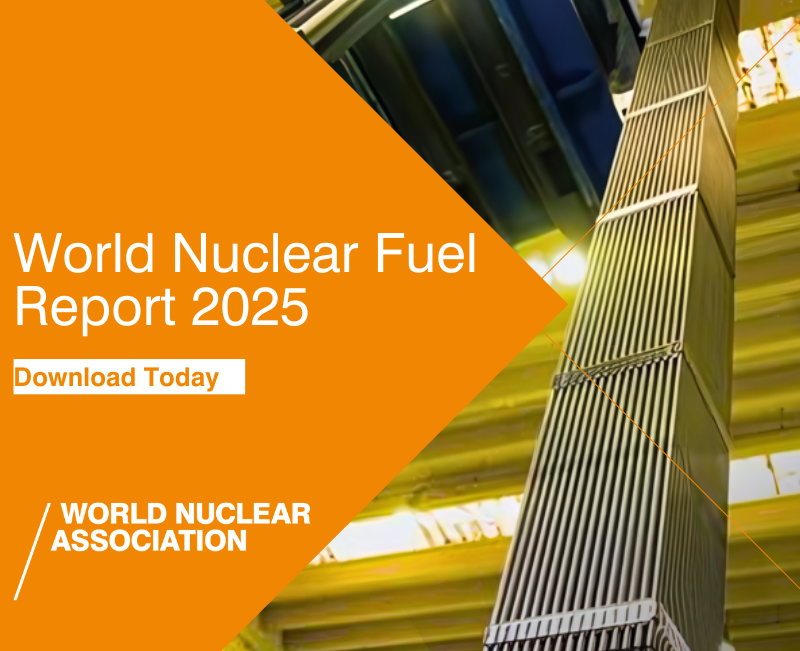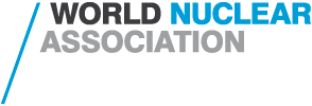The shipping industry consumes some 350 million tonnes of fossil fuel annually and accounts for about 3% of total worldwide carbon emissions. In July 2023, the shipping industry, via the International Maritime Organization (IMO), approved new targets for greenhouse gas emission reductions, aiming to reach net-zero emissions by, or around, 2050.
"Nuclear propulsion, once regarded as a distant prospect, is now under active consideration as a real option for the commercial maritime fleet," DNV Senior Principal Researcher Ole Christen Reistad says in the foreword a new white paper. "Shipyards and shipowners are exploring its potential and weighing the promise of virtually emission-free power against the complexity of introducing such a transformative technology into commercial fleets."
DNV's white paper - titled Maritime nuclear propulsion: Technologies, commercial viability, and regulatory challenges for nuclear-powered vessels - highlights how maritime nuclear technologies differ from land-based reactors, and emphasises the need to address technological, regulatory, and commercial factors in the effort to understand the potential role of nuclear propulsion. The paper addresses the main elements of the future maritime fuel cycle – including fuel management, waste handling, vessel construction and operation, and oversight of nuclear supply chains – and presents the reactor technologies most likely to be adopted by shipowners. Advances in automation, digitalisation, and modular design are identified as critical enablers of safety, security, and non-proliferation of future nuclear fuels and reactors, thereby paving the way for public acceptance.
"All maritime nuclear technologies will differ from land-based equivalents due to some key characteristics, such as mobility, exposure to harsh sea conditions, and operational profile," the paper notes. "Further, maritime installations will vary significantly depending on their purpose - propulsion (nuclear-powered ships) or power generation (floating nuclear power plants)."
DNV says a cost-effective and proven nuclear fuel cycle, tailored for maritime use, must be developed by the industry. This includes establishing clearly defined roles and responsibilities across the supply chain, from fuel production and reactor integration to loading, exchange, and disposal. "Crucially, storage and disposal of spent nuclear fuel are fundamental to the functionality and credibility of the supply chain. Reactor design and fuel type will directly influence these requirements, and these factors must be addressed before any operating licence is granted."
As part of this, it says provisions for the whole maritime fuel cycle - including long-term waste management - are essential, not only for regulatory compliance but also for advancing public acceptance.
The development of a commercial maritime nuclear industry also needs to be supported by a "predictable and internationally accepted" regulatory framework, DNV says. Organisations such as the IMO and the International Atomic Energy Agency must lead efforts to establish standards for fuel management, ship construction, and operational protocols. "Classification societies will play a critical role in enabling global adoption, helping to overcome the fragmented nature of the land-based nuclear industry and fostering a standardised maritime approach," it says.
DNV noted: "The regulatory landscape for nuclear shipping will likely exceed what the maritime industry is accustomed to, opening the door to multiple future system configurations. By identifying key actors, their mandates, and the need for coordination, regulatory roadmaps outlined in this white paper offer essential guidance. As roles multiply, clarifying interfaces becomes increasingly important - something these roadmaps help address by mapping key interdependencies."
The success of future maritime nuclear installations will also depend on the development of compelling business models, according to DNV. It says these must reflect the commercial realities of shipping and provide a clear understanding of total cost of ownership, especially across the entire fuel cycle. "Cost-competitiveness could be significantly enhanced through modular and standardised approaches, which streamline construction, simplify maintenance, provide independent assurance, and facilitate regulatory approval across jurisdictions."
DNV case studies presented in the paper show that nuclear can out-perform other technologies under both low and high fuel price scenarios. A reactor cost below USD18,000/kW could be competitive if full decarbonisation is achieved by 2050, it suggests, while costs below USD8,000/kW could be viable even without full decarbonisation.
"Realising the potential of nuclear propulsion in maritime requires more than technological readiness," DNV concludes. "It demands coordinated global action, involving a wide range of actors across the maritime industry, regulators, and society in general. With strategic investment and international collaboration, nuclear energy could become a cornerstone of the maritime energy transition, delivering safe, efficient, and zero-emission propulsion for the global fleet."
Approval of container ship design
The release of the white paper came as DNV awarded South Korea's HD Korea Shipbuilding & Offshore Engineering (HD KSOE) - a subsidiary of HD Hyundai - Approval in Principle for a new 15,000 TEU-class container vessel design powered by small modular reactor (SMR) technology. The vessel concept incorporates a supercritical CO2-based power generation system, which can provide higher thermal efficiency and a reduced equipment footprint compared to conventional steam-based systems.
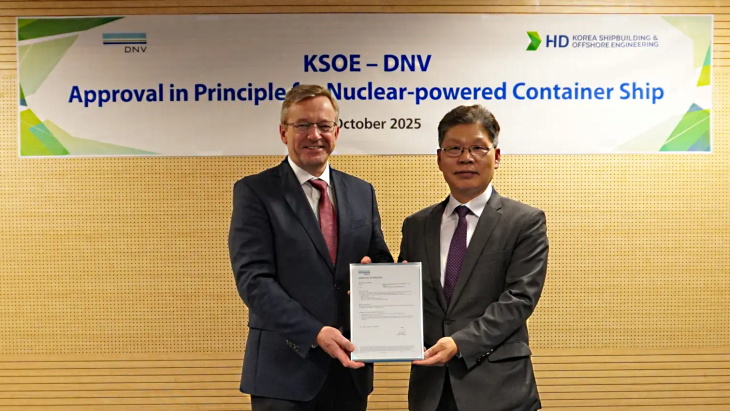
DNV Technical Director Geir Dugstad (left) and HD KSOE Senior Vice President Sungkon Han (Image: DNV)
An Approval in Principle (AiP) is an independent assessment of a concept within a defined framework of requirements. It confirms the feasibility of the design and verifies that no significant technical barriers exist to its implementation.
During the development of the ship design concept, the DNV team worked closely with HD KSOE to assess the vessel's overall safety and the design of the advanced power generation system. This review included the vessel's main functions, power supply and overall approach to safety. In May 2025, HD KSOE and DNV also conducted a HAZID (Hazard Identification) workshop at DNV's headquarters in Oslo to identify potential risks and accident scenarios for nuclear-powered vessels and to guide improvements in the design.
"This SMR-powered container vessel concept represents a key milestone in our efforts to explore alternative fuels for decarbonising shipping," said HD KSOE Chief Technology Officer Chang Kwangpil. "The design focuses intensely on the safety of the vessel and advancing the propulsion system in the application of SMR technology. In addition, we have developed a novel shielding and containment system, which is designed to maintain reactor safety and vessel survivability even in the event of collisions, groundings, or sinking accidents. We will continue to collaborate with global partners to advance marine nuclear technologies."
"With little recent experience in utilising nuclear power for cargo vessels, this AiP represents an important first step in building the technical verification process for nuclear-powered vessels," said Geir Dugstad, Technical Director at DNV. "We are very pleased to award KSOE this new AiP, which is the well-deserved result of an intensive and productive cooperation, which we look forward to continuing as this exciting technology continues to develop."
Previously, HD KSOE obtained Approval in Principle from the American Bureau of Shipping for a 15,000 TEU-class container ship design model applying SMR technology.

_43508.jpg)



_82983.jpg)
_34792.jpg)
_16403_79272.jpg)
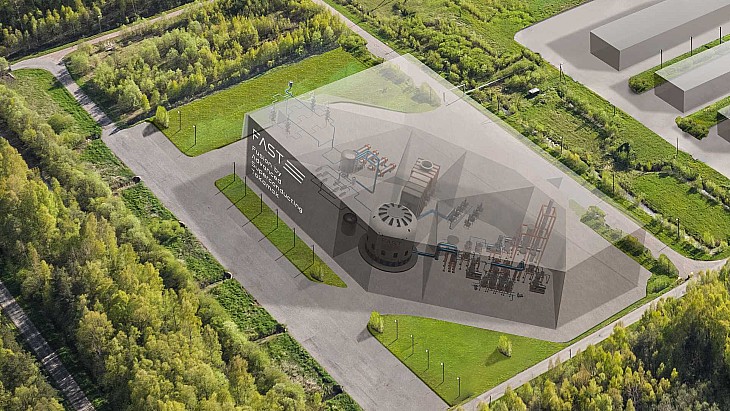
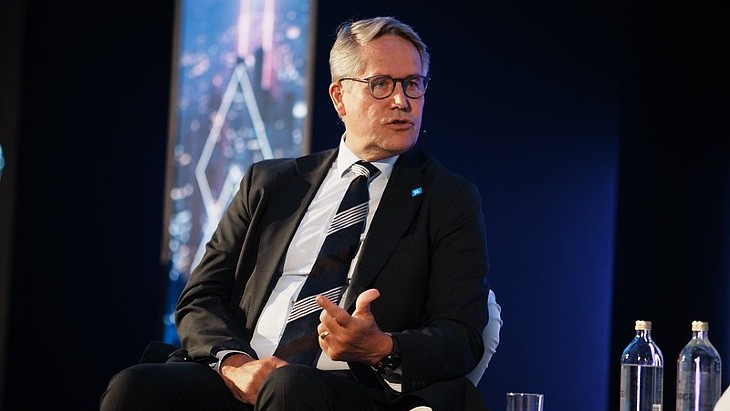
_76087_55556.jpg)
